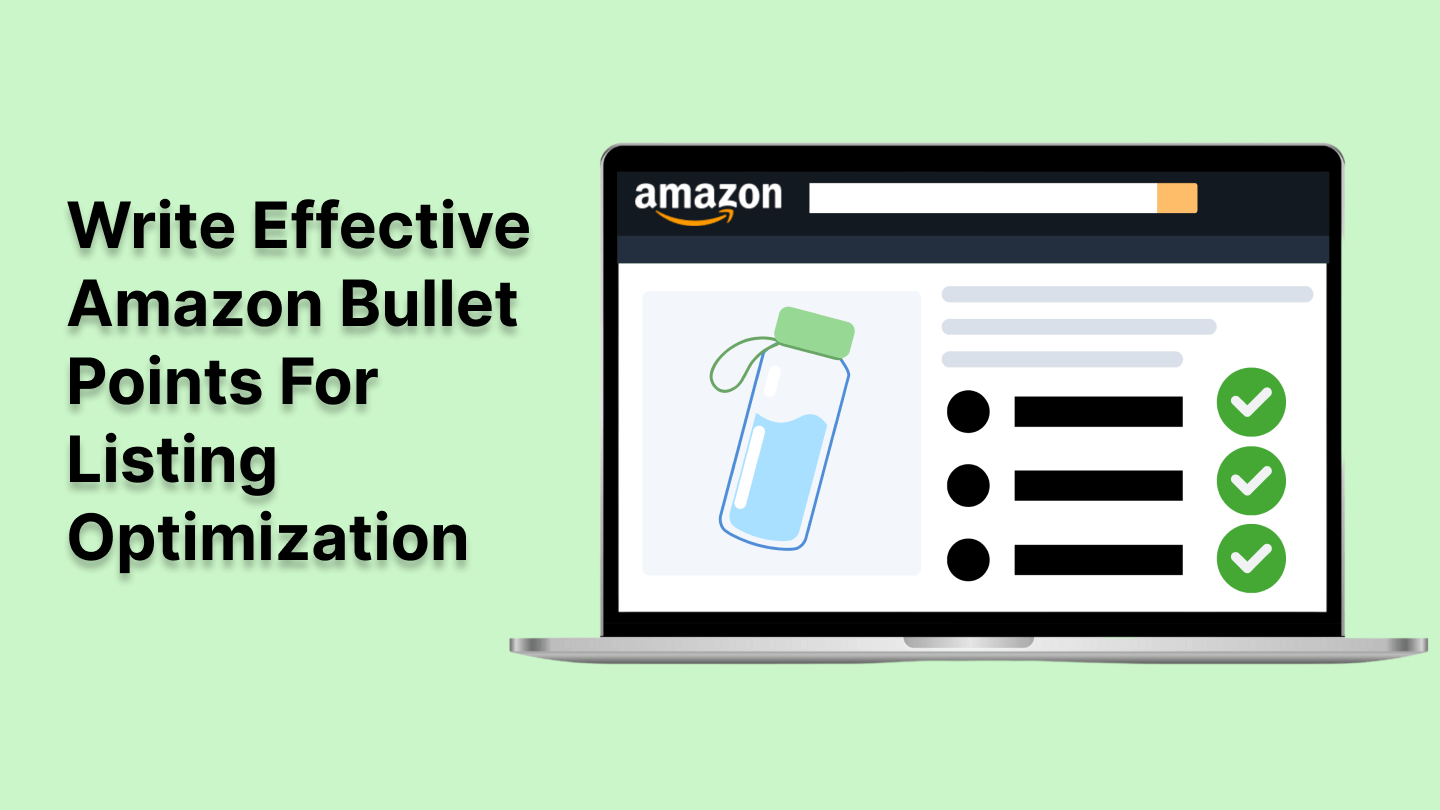Creating optimized Amazon listings is one of the most important things you can do when selling private-label products.
By optimizing your listings, you’ll make them stand out, convince customers to buy your product, and boost your visibility in the search results.
Product listings are made up of several sections. The bullet points, or key product features, are one of the most important of these.
In this guide, we’ll cover how you can create optimized bullet points to ensure your listing is fully optimized.
TL;DR
- The bullet points are important in any Amazon product listing, and you should spend some time on getting them right.
- They can play a role in your listing’s visibility in the Amazon search engine.
- They’re also responsible for helping to persuade shoppers to become customers.
- Make your bullets concise, use the most important keywords, include both features and benefits, and keep them skimmable to get the best results.
What Are Amazon Bullet Points?

When you visit an Amazon listing, you’ll see that it’s divided into several sections: the product title, product description, images, and bullet points.
The bullet points are usually positioned below the title and adjacent to the product image on the Amazon website. On mobile versions of the website and in the app, they sometimes appear in different places.
They consist of five short sections, and they outline the primary features and benefits of the product.
They’re usually brief, scannable, and contain the essential information you need to know about the product to help make a more informed buying decision.
Why Bullet Points Matter
Bullet points are one of the most important parts of your product listing.
The product title is the first thing that people see alongside the product image. But the bullets present a lot more information than the title.
People notice them and read them. Many people will not get past the bullet points, and if they don’t find what they’re looking for, they’ll leave instead of going on to read the product description.
The bullets inform shoppers and persuade them. In fact, you could find that you convince the shopper to buy your product due to the information you include in the bullet points.
People want to quickly find the information they need to make a decision, and that will usually be found in the key features.
Bullet points help your listing stand out from competitors and sell your product. However, you could just as easily lose a sale by failing to optimize your bullet points.
Bullet points are also important for increasing the visibility of your product listing in the search engine results because of the importance of keywords—which we’ll look at next.
The Importance of Keywords in the Bullet Points
One of the things that you need to remember with the bullet points is that they should be optimized for the A10 algorithm.
The keywords you use in the bullets are important for your search visibility. They have more weight than the keywords you use in the product description, so you should try to get your most important keywords into the product title and bullet points.
If you accomplish this while ensuring your bullet points are clear and engaging rather than keyword-stuffed, you’ll help to improve your visibility in the search results pages.
How to Find the Best Keywords
We won’t go into too much detail here about finding keywords, but it’s an area you want to take seriously.
It’s usually best to use a keyword research tool like MerchantWords, although there are many others to choose from.
Use your chosen keyword tool to generate a list of the most important keywords you need to use, and order them by their importance so you know which to use in the bullet points.
10 Ways to Create Effective Bullet Points
Bullet points may seem relatively simple, but there’s a lot to consider if you want to ensure they’re as effective as they can be. Here are 10 ways you can do that.
1. Utilize Important Keywords
First of all, let’s focus on keywords. We’ve already mentioned these, but they should be the foundation of your bullet points. Don’t start creating your bullets without first knowing which keywords you’ll use.
However, you should avoid keyword stuffing. While it’s good to use keywords, you don’t want that to be at the expense of clarity and persuasiveness.
Also, there’s no reason to use a keyword more than once anywhere in the listing. That includes the product title, bullets, product description, and backend keywords section.
Once you have used a keyword once, it’s counted by the algorithm. This is a positive thing because it helps to avoid the temptation to stuff your listing with keywords.
Try to choose a few keywords that you want to get into each bullet point. You only need about two or three in each, so you include about 10 to 15 of your most important keywords in all the bullet points.
Be creative and use them in a persuasive way to make your bullet points sound more appealing.
Related: Complete Guide to Amazon Keyword Research in 2023
2. Pick Out the 5 Most Important Features
When people visit your listing, they want to see the most important information first. So this is what you need to include when you add bullet points to your listing.
It takes a bit of brainstorming, so sit down and think about the main features, and look at other similar products to see what they have used.
You could even look at 10 similar products, copy their points into a spreadsheet, and find out which features are highlighted the most for inspiration.
When you’re determining your product’s main features, consider:
- What makes your product stand out?
- What makes it different?
- What are its advantages?
- Why would someone choose yours instead of a similar product?
Each of the five bullet points should only contain one feature or benefit. Don’t try to cram lots of separate points into each bullet point. Instead, list your most important features and choose the top five. You can list the rest of the features in your product description.
When you create the copy, be clear, stick to the facts, and avoid making subjective statements (e.g. This is the best product on the market”).
3. Focus on the Top 2 Bullets
When you have chosen your five primary features, list them in order of importance. What’s the number one thing that makes your product better than the rest? Put this one first.

The top two bullet points are the place to put them because many people will not look beyond these two.
On mobile, or if your bullets are very long, the other points may even be hidden unless the shopper chooses to see them.
This is where you need to find out what your customers really want. Do this by reading reviews of competing products and your own to find out what people really want. The things that keep on coming up are the things you want to feature first.
This is how you’ll connect with them because they will instantly see that your product has the features they want.
4. Focus on Benefits as Well as Features
This is one of the most important things to remember when it comes to bullet points. While they’re called key product features, this doesn’t mean you should only focus on features.
In copywriting, there’s a difference between the features and benefits. The feature is what it is; the benefit is why it’s important.
Importantly, benefits sell. They’re emotional, and people can connect with them on an emotional level.
Benefits are what the product does for them. For example, it could save them time, make their life easier, or save them money.
You don’t want to just list the benefits; that’s not how it works. Instead, you want to include them along with the features.
This is quite a skill, and it can take some time to really crack it. The best way to get an idea of how to do this is to look at other listings.
There’s no one right way to do this, but one option is to list a brief benefit at the start of the bullet point followed by how this benefit relates to a specific feature.
However, there’s another option that’s the exact reverse. In this version, you highlight a feature at the start of the bullet point and then explain how this feature makes life better for your customers.
You may find that one of these options works better for your listening than the other, so play around with both options.
Sales copy can take a while to get the hang of, but it can make a big difference and make your product sound more appealing. This can help encourage people to click the buy button, so it’s worth getting right.
5. Make Them Skimmable
When you write Amazon bullet points, start by making them as long as you want them to be. Just ensure they’re optimized for the most important features and corresponding benefits.
You may end up with bullet points that are a few hundred words long. That’s fine for now. But when you have finished then, you need to edit them down to make them skimmable.
People have short attention spans. Many shoppers will be tempted to click on your listing because of the title and image. When they arrive, they will scan over the information, but many won’t get past the bullets.
And even then, they may not read all of the information. They want to see the most important information front and center.
Only then will they make a decision to either buy, read the full product description, or leave.
As such, you want your bullets to be as skimmable as possible. That means making them punchy and focusing on one primary point in each bullet point.
You should list the first words of each bullet point in capital letters to make them stand out.
Your goal should be to grab attention with concise and valuable information that provides the shopper with the knowledge they need to make a decision.
6. Use Simple Language
Always keep things simple in your bullet points. You don’t want to scare shoppers off by putting in long words or complex information that they don’t understand.
Keep the focus on your product’s most important features and benefits. Explain these as though you’re talking to someone who has no idea about that product.
Avoid technical jargon and keep things clear and easy to understand. Don’t assume that people will know what technical language means.
Complex and convoluted language has no place in your Amazon listing, and especially not in the bullet points.
Your bullet points should entice shoppers to find out more.
7. Address Common Pain Points
Another thing you can do in your bullet points is address the pain points that your customers have. This is another key part of sales copywriting.
All of your customers are buying your product because it will make their lives better in some way.
That could be to save them time, or to make them more comfortable and happy. While we’ve already mentioned focusing on the benefits, you can also address the pain points.
This is essentially turning the benefits around.
Brainstorm the key problems that your target customers are facing and the reasons why they’re looking for your product in the first place.

Put yourself in their shoes and understand the situation that has driven them to search Amazon for your product. Then mention these in the bullets.
Using pain points creates empathy. You’re saying that you understand their situation and their problems, and you can then present your product as the solution to these problems.
Look at your reviews and those of competing products to generate ideas for pain points. Many customers will mention them, so use them.
8. Use the Language of Your Customers
Another idea is to use the language of your customers in your bullet points.
This means going over your reviews and picking out key phrases that customers use when referring to your product.
This could include words they use to describe your product or words they use to talk about their problems and how your product helps.
Don’t just copy their reviews, but do pick out relevant words they use, especially those that come up frequently.
Doing this can help to make your bullet points more real so you can connect with your customers on a more emotional level.
You speak directly to them, and they recognize themselves in your copy, which can encourage them to trust you more and reach for their wallets.
9. Keep Them Simple
One of the most important overall things to keep in mind when you’re creating great bullet points is to keep them simple.
We’ve already touched on this, but it deserves a special mention.
This isn’t the place to go into complex language with long, drawn-out points. Instead, keep them simple and concise.
This can actually be difficult, especially when you’re enthusiastic about your product and you have a lot to say.
Even though you have a character limit, this does not mean you have to use the full limit. Long bullet points are more likely to get cut off so shoppers only see the first couple of bullet points.
Be simple and concise, and make them persuasive. Follow all the points above, and you’ll end up writing bullet points that are much more effective and convincing than those used by the majority of your competitors.
10. Stick to the Rules
Finally, it’s important to stick to the rules and limits set out by Amazon when creating your bullet points, just as it is with any other part of your listing.
These rules can always change, so make sure you find out about the specific requirements in place when you create your own bullet points.
In general, each single bullet point can be up to 500 characters each, but aim for less. Try to make them about 200 characters for each, or 1,000 characters in total.
Each bullet point should focus on a specific feature or highlight of your product.
Don’t include information about the price of your product in the bullet points. And avoid talking about your shipping, company, or what you do.
Avoid promotional content like sales and discounts you’re running. Instead, the focus should always be on the product itself.
You should also avoid using HTML like bold text. The only way you can make the text stand out is by using a few words in capital letters, but this should only be at the start of each bullet point.
Compare with Your Competitors’ Listings
Use the above points to come up with your own bullet points. Edit them, check them, edit them again until you’re happy.
When you have done everything that you can on them, take a look at the bullet points created by your competitors.
This can be revealing, and you can learn a lot about your competitors and your customers this way.
- Which features have your competitors chosen to focus on?
- Which have they put first in the list?
- Is there anything you have forgotten that you should include?
- Are their bullet points more convincing and persuasive than your own?
Use these other bullet points to make the final edits to your own. Don’t copy them, but do use them to add any information that you may have missed.
Use Feedback to Improve Bullet Points
Once you have created the perfect bullet points, add them to your listing. But don’t stop there.
As with everything in your Amazon business, you should take the opportunity to improve them over time.
As you start getting more reviews from your customers, use these to your advantage. Read as many reviews as you can, and use the information you find to improve your bullets.
If customers start mentioning particular problems they’re facing, or things they love about your product that you had not thought of before, use them.
Keep optimizing your bullet points over time and make sure they’re helping to generate more sales for your business.
Benefit from Effective Bullet Points
Bullet points are an important part of any Amazon listing, so avoid the temptation to write them down quickly and forget about them.
There are lots of things you have to focus on when running an Amazon business, from advertising to managing your pricing strategy using automated repricing software.
While these are all important, make sure the copy you create is working hard for you.
Bullet points provide you with an opportunity to not only incorporate your most important keywords to boost the visibility of your listing, but also to persuade shoppers that they’re making the right decision by choosing your product.
Spend time brainstorming ideas, creating the bullet points and editing them down to be clear and concise.
Keep updating and editing them as you learn more about your customers and their needs, especially as you gather information from customer reviews.
Writing great Amazon bullet points can play an important role in boosting your conversion rates, making your product stand out and generating more sales for your business.






